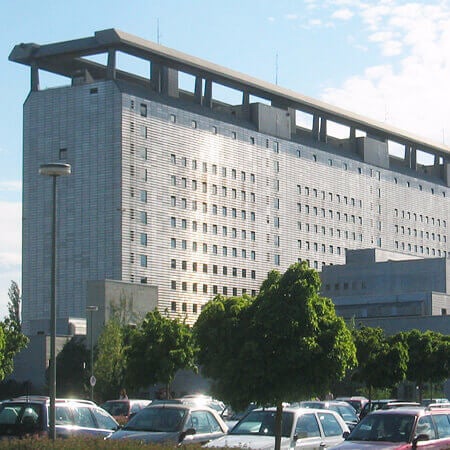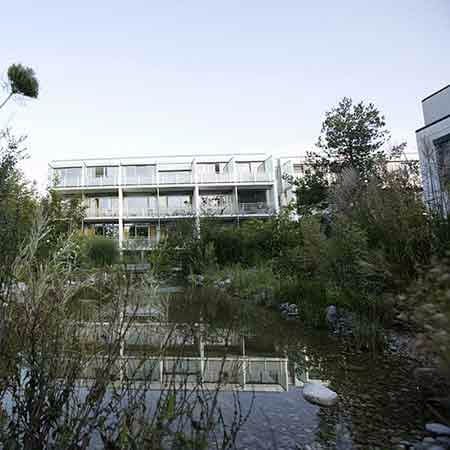Teratoma is a rare testicular neoplasm. It rarely spreads distant metastases, but often invades retroperitoneal lymph nodes and is highly resistant to chemotherapy. Most patients with teratoma are successfully cured abroad. Doctors in developed countries perform minimally invasive surgical interventions for retroperitoneal lymph node removal, use modern chemotherapy regimens and new, patient-safe methods of radiation therapy.
Content
- What is testicular teratoma
- Surgical treatment
- Chemotherapy
- Radiation therapy
- Treatment of recurrence
- Why is it worth undergoing treatment abroad
- Treatment in Europe with Booking Health at an affordable price
What is testicular teratoma
Germ cell tumors are the most common malignant neoplasms in men under the age of 35 years. Most of them, including teratoma, are successfully treated.
Testicular cancer is divided into two large groups, namely:
Seminomas account for 90% of cases of testicular cancer – this is the most common tumor. Only 10% are diagnosed with non-seminomas. There are four types of testicular cancer in this group: embryonal carcinoma, yolk sac tumor, choriocarcinoma and teratoma. Even among these rare types of testicular cancer, teratoma ranks last in the frequency of detection. However, it is not necessarily pure teratoma, because teratoma cells can be found in mixed testicular cancer.
Teratoma is testicular cancer, the components of which originate from more than 1 layer of germ cells. This tumor can be mature and immature. The mature one consists of differentiated cells, while the immature is only partially differentiated. Teratoma is a relatively good predictor of testicular cancer. It often metastasizes to the retroperitoneal lymph nodes, but very rarely to the internal organs. A feature of the tumor is considered to be low resistance to chemotherapy, and therefore the main role in the treatment belongs to a surgical intervention.
A large study at Indiana University (USA) with the participation of 1224 patients, 689 of whom were diagnosed with teratoma in testicular cancer samples, showed that its presence did not affect the prognosis. For patients with teratoma cells in the tumor, survival rates are the same as for patients with other non-seminomas.
Surgical treatment
Surgery is the main treatment of testicular seminomas and non-seminomas, including teratomas. In case of testicular cancer with teratoma in the composition, high-quality surgical treatment becomes especially important for patient survival. This is due to the fact that this type of testicular cancer is not sufficiently amenable to chemotherapy. Therefore, if during the surgery the doctor leaves tumor foci, there is a high probability of their progression.
Radical inguinal orchiectomy (orchifuniculectomy). When performing the surgical intervention, the doctor removes the entire testicle, epididymis, and spermatic cord. An incision is made in the groin. Unlike the scrotal approach, this one has a lower risk of cancer cell proliferation and local recurrence after testicular cancer excision. This surgery is the most common treatment for testicular cancer, regardless of the stage. It is minimally traumatic. Patients recover quickly and spend a minimum of time in the hospital.
Retroperitoneal lymph node dissection. This is additional surgery for testicular cancer, which is especially important for teratoma that does not respond well to chemotherapy. It can be performed as a stand-alone procedure or as part of a single operation, during which the doctor removes both the testicle and retroperitoneal lymph nodes.
As a rule, the doctor does not know what kind of tumor he is dealing with when he starts testicular cancer treatment. A biopsy is not performed prior to surgery. The material for histological examination will be obtained only after the operation, and the doctor will be able to determine the type of tumor: seminoma or non-seminoma, whether there are teratoma cells in the testicular cancer.
Some testicular cancers respond well to chemotherapy and radiation. Radiation therapy is mostly used for seminomas, while postoperative chemotherapy can be used both for seminomas and non-seminomas. Therefore, if lymph nodes do not have any clinical signs of metastases, they can not be removed. Nonetheless, after the completion of treatment, the patient requires follow-up monitoring and testing of tumor marker levels in order to detect a relapse in time.
If teratoma components are found in the removed tumor, retroperitoneal lymph node dissection is desirable. This surgery allows the doctors to check the lymph nodes, to establish the exact stage of testicular cancer, and also to prevent regional recurrence of the tumor in conditions where chemotherapy may not destroy all cancer cells.
Laparoscopic and robot-assisted lymph node dissection. Although retroperitoneal lymphadenectomy for testicular cancer is usually a traumatic operation performed through a large skin incision, developed European countries also perform it with the use of minimally invasive techniques. The intervention is performed through short incisions using video endoscopy. The doctor inserts thin long instruments and a video camera into the patient's body, after which performs all manipulations under the guidance of imaging on the screen. Some hospitals have robot-assisted surgical systems, which doctors control remotely with a special console. Robot-assisted interventions are even safer. Patients are less likely to suffer complications, lose less blood, spend less time in the hospital, and recover more quickly after surgery.
Chemotherapy
Patients with stage 2-3 usually receive chemotherapy. It is also required at stage 1, if doctors did not remove the retroperitoneal lymph nodes, but performed only orchifuniculectomy.
The chemotherapy regimen for testicular cancer is selected individually. It depends on the risk group that the patient belongs to. There are three risk groups: high, intermediate and low. The risk category for testicular cancer is classified according to the IGCCCG (International Germ Cell Cancer Collaborative Group) scale. It takes into account clinical, biological characteristics of testicular cancer, as well as tumor marker levels.
In case of high risk testicular cancer, patients with non-seminoma receive one of the following regimens:
- 3 cycles of bleomycin, etoposide and cisplatin.
- 4 cycles of cisplatin plus etoposide.
In case of intermediate and low risk testicular cancer, the regimens are as follows:
- 4 cycles of etoposide, ifosfamide and cisplatin.
- 4 cycles of bleomycin, etoposide and cisplatin.
Unlike other non-seminomas, teratoma does not respond well to chemotherapy. For some types of testicular cancer the effectiveness of the drugs exceeds 90%, but for teratoma this indicator is only 54%.
A series of studies from Indiana University showed that after chemotherapy for teratoma, 85% of patients have signs of testicular cancer in distant metastases. If teratoma is not included in the composition of the neoplasm, then the frequency of detection of signs of testicular cancer is 48%. Thus, non-seminomas that do not contain teratoma are better cured with chemotherapy. For patients, this means a higher likelihood of repeated surgery for recurrent tumor resection.
Radiation therapy
Radiation is rarely used for testicular cancer with teratoma. Basically, doctors use this treatment method for seminoma. Non-seminomas are less sensitive to radiation therapy.
In case of seminomas, irradiation after testicular removal surgery may be part of standard treatment. Radiation destroys possible lymph node metastases, so patients can avoid retroperitoneal lymphadenectomy. Even in seminoma, however, radiation is not used as often as chemotherapy because of the higher risk of side effects.
With non-seminomas that contain teratoma cells, radiation therapy is used very rarely. It is mainly used at the advanced stage of testicular cancer for suppressing metastases, for example, in the brain. Nonetheless, teratoma rarely metastasizes to distant organs. Accordingly, most patients do not need radiation therapy.
Treatment of recurrence
Recurrences most often appear in the retroperitoneal lymph nodes. They develop in patients with non-seminoma who have been treated with only testicular removal surgery, possibly with drug therapy, but without retroperitoneal lymph node dissection. The recurrence from the tumor foci remaining after surgery is also possible.
In such cases, treatment options for patients with non-seminoma depend on the type of therapy they have undergone previously. The worst prognosis is noted in teratomas that have recurred after chemotherapy. In addition, these neoplasms usually do not increase tumor marker levels, so recurrences are detected later.
Patients usually require repeated surgery. It may be preceded by chemotherapy. If standard therapy does not work, high-dose chemotherapy with stem cell transplant is used.
Less often, non-seminoma causes recurrence in other organs, which indicates the development of distant metastases. Treatment options for these patients depend on the location of the metastatic tumor. If it is located in the brain, radiation therapy is often used, if in the liver, hepatic artery chemoembolization is used. Metastatic foci in the lungs are removed surgically.
Why is it worth undergoing treatment abroad
To benefit from top-class medical care, patients with testicular cancer can undergo seminoma and non-seminoma treatment abroad. Medical facilities abroad employ surgeons with vast experience in teratoma removal surgery. The high-quality equipment in hospitals makes surgical treatment and radiation therapy safe for the patient.
There are several reasons for you to undergo treatment for non-seminoma with teratoma in its composition abroad:
- The probability of curing teratoma for patients with testicular cancer in the best European hospitals reaches 98%.
- Retroperitoneal lymph nodes are removed laparoscopically. After such surgical interventions, patients with testicular cancer are less likely to suffer from complications and recover faster.
- The use of nerve-sparing techniques. Therefore, patients with testicular cancer are less likely to develop retrograde ejaculation.
- Some hospitals perform robot-assisted surgery for retroperitoneal lymph node removal. For testicular cancer patients, they are even safer and more sparing than laparoscopic ones.
- Successful treatment of non-seminoma even at the advanced stage is possible: with the help of radiation therapy, surgical removal of metastases, high-dose chemotherapy with stem cell transplant.
- The very latest radiation therapy options provide precise targeting of radiation to the tumor and reduce the risk of post-radiation complications.
- Comfortable conditions in hospitals, high-quality pain management, comprehensive care for patients with testicular cancer, accompanying and symptomatic therapy.
Treatment in Europe with Booking Health at an affordable price
To undergo testicular teratoma treatment in one of the European hospitals, you can use the services of the Booking Health company. On our website, you can see the cost of treatment and compare prices in different hospitals in order to book a medical care program at a favorable price. Treatment in European hospitals will be easier and faster for you, and the cost of treatment will be lower.
You are welcome to leave your request on the Booking Health website. Our specialist will contact you and provide a consultation on treatment in Europe. Booking Health will fully organize your trip abroad. We will provide the following benefits for you:
- We will select the best European hospital, whose doctors specialize in the treatment of testicular teratoma.
- We will help you overcome the language barrier and establish communication with the doctor of the European hospital.
- We will reduce the waiting time for the medical care program. You will undergo treatment on the most suitable dates.
- We will reduce the price. The cost of treatment in Europe will be lower due to the lack of overpricing and additional coefficients for foreign patients.
- We will take care of all organizational issues: we will draw up documents, meet you abroad and take you to the hospital, book a hotel, and provide interpreting services.
- We will prepare a program and translate medical records. You do not have to repeat the previously performed diagnostic procedures.
- We will help you keep in touch with doctors after the completion of treatment in Europe.
- We will organize additional examinations and treatment in the European hospital.
- We will buy medicines abroad and forward them to your native country.
Your health will be in the safe hands of the world's leading doctors. The Booking Health specialists will help you reduce the cost of treatment, organize your trip to the European hospital, and you will only have to focus on restoring your health.
Authors: Dr. Nadezhda Ivanisova, Dr. Sergey Pashchenko
















